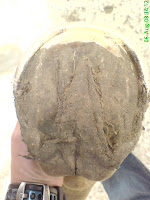





To be a better trimmer I need to see a wider variety of cases. So I have taken myself off to Dallas to train with Jamie Jackson. He has updated his training programme and its much more intensive and rigorous than previously. Which is just as well because I know I have a lot to learn.
We are practising on a mix of cadavers and live horses. Although it is sad and sometimes unpleasant to think about the dead horses, I would rather make my mistakes on them than a live one. The fatal mistakes have already been made on the dead horses and sometimes the evidence is in their feet.
The pictures above show what could have been a good foot that over a relatively short time period could have been rehabilitated. It has bull nose and compacted soles from inappropriate foot care. The later pictures show the compacted sole coming out and what the foot looks like after one trim.




















































